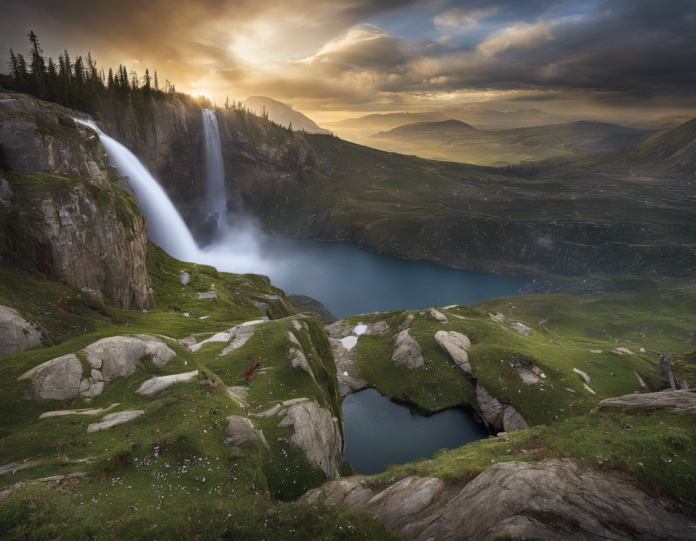Nature has always mesmerized and captivated us with its dazzling beauty, diverse ecosystems, and intriguing phenomena. From the magnificent mountains to the depths of the oceans, Mother Nature never fails to impress us with her wonders. Let’s embark on a journey to explore some of the most awe-inspiring aspects of nature that leave us in sheer amazement.
The Power of Waterfalls
Waterfalls represent the sheer force and elegance of water as it cascades down steep cliffs, creating a breathtaking spectacle. One of the most famous waterfalls is the Niagara Falls, located between the United States and Canada. The sheer volume of water plunging over the edge is a sight to behold, leaving visitors in awe of its power.
Key Points about Waterfalls:
- Waterfalls are formed when a river or stream flows over a cliff or steep drop.
- The height and volume of a waterfall determine its visual impact and intensity.
- Waterfalls play a crucial role in shaping landscapes and creating unique habitats for plants and animals.
The Enigmatic Northern Lights
The Northern Lights, also known as Aurora Borealis, are a natural light display that illuminates the night sky in high-latitude regions. This mesmerizing phenomenon is caused by the interaction of solar winds with the Earth’s magnetic field, creating a dazzling display of colors that dance across the sky.
Fascinating Facts about the Northern Lights:
- The colors of the Northern Lights are determined by the type of gas particles colliding with the Earth’s atmosphere.
- The best time to witness the Northern Lights is during the winter months in regions close to the Arctic Circle.
- Indigenous cultures around the world have their own myths and legends to explain the origin of the Northern Lights.
The Mystique of Coral Reefs
Coral reefs are vibrant and diverse underwater ecosystems that are home to a myriad of marine species. These intricate structures are formed by living coral polyps that secrete calcium carbonate to create massive colonies over time. The Great Barrier Reef in Australia is the largest coral reef in the world, showcasing a kaleidoscope of colors and marine life.
Crucial Points about Coral Reefs:
- Coral reefs provide vital habitats for numerous marine species, including fish, turtles, and sharks.
- The health of coral reefs is under threat due to factors such as climate change, pollution, and overfishing.
- Conservation efforts are underway to protect and preserve coral reefs for future generations.
The Majesty of Mountains
Mountains stand tall and majestic, symbolizing strength, resilience, and grandeur. From the towering peaks of the Himalayas to the rugged terrain of the Andes, mountains have inspired awe and reverence in people across the globe. Mount Everest, the highest peak in the world, continues to be a symbol of human endeavor and the spirit of exploration.
Noteworthy Aspects of Mountains:
- Mountains are formed through tectonic processes, including volcanic activity and plate movements.
- Mountainous regions are critical for regulating global climate patterns and water cycles.
- Mountaineering and trekking have become popular activities for adventure enthusiasts seeking to conquer new heights.
The Serenity of Forests
Forests are lush and bountiful ecosystems that harbor a rich diversity of plant and animal life. From the dense rainforests of the Amazon to the tranquil woodlands of Japan, forests provide essential resources and habitats for countless species. The Amazon Rainforest is often referred to as the “lungs of the Earth” due to its role in producing oxygen and regulating the climate.
Essential Facts about Forests:
- Forests are crucial for carbon sequestration, helping to mitigate the effects of climate change.
- Deforestation and logging pose significant threats to the health and sustainability of global forests.
- Conservation efforts and sustainable practices are vital for protecting the world’s forests for future generations.
The Splendor of Deserts
Deserts are vast and arid landscapes that evoke a sense of mystery and fascination. From the scorching sands of the Sahara to the icy expanses of Antarctica, deserts encompass a diverse range of environments with unique adaptations and survival strategies. The Atacama Desert in Chile is known for its otherworldly beauty and extreme dryness.
Key Characteristics of Deserts:
- Deserts receive minimal precipitation and often experience drastic temperature fluctuations between day and night.
- Despite the harsh conditions, deserts support a variety of plant and animal species specially adapted to survive in arid environments.
- Deserts play a crucial role in shaping landscapes and geological formations over millions of years.
Conclusion
Nature’s wonders are a testament to the beauty, complexity, and resilience of our planet. From the roaring waterfalls to the tranquil forests, each aspect of the natural world offers a glimpse into the incredible diversity and interconnectedness of life on Earth. As we continue to explore and appreciate Mother Nature’s marvels, let us also strive to protect and preserve these precious resources for generations to come.
Frequently Asked Questions (FAQs)
1. What is the significance of biodiversity in nature conservation?
Biodiversity refers to the variety of life forms and ecosystems on Earth, which play a crucial role in maintaining ecological balance, resilience, and sustainability. Conserving biodiversity is essential for protecting species, habitats, and the overall health of our planet.
2. How do climate change and human activities impact natural ecosystems?
Climate change, along with human activities such as deforestation, pollution, and habitat destruction, poses serious threats to natural ecosystems and biodiversity. Rising temperatures, extreme weather events, and loss of habitat can disrupt delicate ecological balances and lead to species extinction.
3. What are some effective ways to contribute to nature conservation efforts?
Individuals can support nature conservation by adopting sustainable practices in their daily lives, advocating for environmental protection policies, supporting conservation organizations, and participating in community initiatives that promote wildlife habitat preservation and restoration.
4. How do national parks and protected areas contribute to nature conservation?
National parks and protected areas serve as valuable refuges for wildlife, ecosystems, and natural heritage. By safeguarding pristine landscapes and habitats, these protected areas help conserve biodiversity, provide recreational opportunities, and raise awareness about the importance of nature conservation.
5. What role do indigenous communities play in nature conservation and stewardship?
Indigenous communities have deep-rooted connections to nature and often possess traditional knowledge and practices that promote sustainable resource management and biodiversity conservation. By respecting indigenous rights and supporting indigenous-led conservation efforts, we can strengthen nature conservation initiatives and foster greater environmental stewardship.



